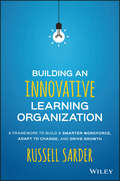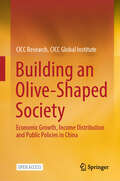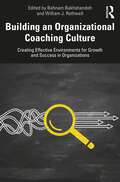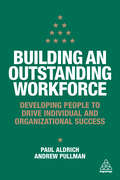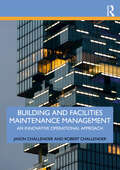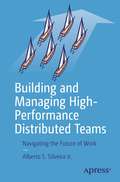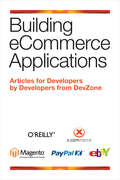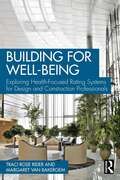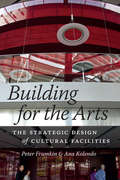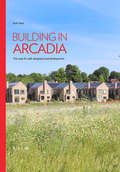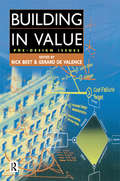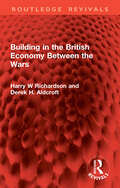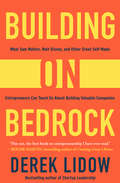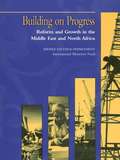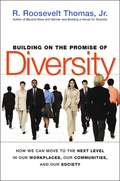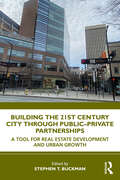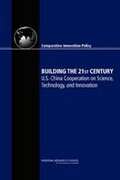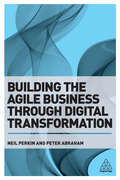- Table View
- List View
Building an Innovative Learning Organization: A Framework to Build a Smarter Workforce, Adapt to Change, and Drive Growth
by Russell SarderInstitute a culture of learning to boost organizational performance and agility What makes organizations successful? Today, most successful companies are learning organizations. Building an Innovative Learning Organization shows you how to join their ranks and bring your organization up to the head of the class. This book is a practical, actionable guide on how to boost performance, successfully manage change, and innovate more quickly. Learning organizations are composed of engaged, motivated employees who continually seek improvement, which leads to organizational agility and the ability to innovate ahead of the curve. When you encourage learning at every level, from the intern to the C suite, you gain a more highly skilled workforce with a greater ability to act in any situation. Building an Innovative Learning Organization shows you how to create this culture in your organization, with detailed explanations, practical examples, and step-by-step instructions so you can get started right away. Written by a recognized thought leader in the training industry, this informative and insightful guide is your roadmap to a more effective organization. You will discover how to: Attract, retain, and motivate the best employees Become a more innovative and agile organization Create a culture of continuous self-improvement Encourage learning at all levels and translate it into action Learning and education doesn't end at graduation--it's a lifelong process that keeps you relevant, informed, and better able to achieve your goals. These same benefits apply at the organizational level, making the culture self-sustaining: learning organizations attract top workers, who drive the organization forward, which attracts more top workers. If you want the best people, you have to be their best option. Building an Innovative Learning Organization gives you a blueprint for building a culture of learning, for a stronger, more robust organization.
Building an Integrated Biopharma Company: Crucell (A)
by Susan S. Harmeling Richard G. Hamermesh Marianne Van Der SteenBy 2009, Crucell had become the largest biopharma company in the Netherlands and a symbol of national pride. The case traces the evolution of the company from a University spin-off into a fully-integrated company. Crucell's success, particularly in the vaccine space, had begun to attract the attention of much larger pharmaceutical companies. While there was much appeal to working with these companies, these relationships could also challenge Crucell's independence. This issue is highlighted by the decision whether to partner with companies that wanted ownership of 10-20% of Crucell as part of the business development deals.
Building an Integrated Biopharma Company: Crucell (B)
by Susan S. Harmeling Richard G. Hamermesh Marianne Van Der SteenThe Crucell (B) case updates events at Crucell since 2009. In September, 2009, Johnson & Johnson acquired 18% of Crucell for $400 million. This investment was part of a business development deal. Subsequently, in 2012, Johnson & Johnson acquired Crucell for $2.8 billion.
Building an Olive-Shaped Society: Economic Growth, Income Distribution and Public Policies in China
by CICC Research, CICC Global InstituteThis open access book offers a comprehensive analysis of China’s way of economic development balancing between efficiency and equity, striving to investigate existing challenges and to discuss the role of fiscal policies and philanthropy to mitigate social inequality. The book analyzes the current overall state and challenges of China's income and wealth distribution and describes the social inequality in specific fields such as labor market, housing markets, education, public health, infrastructure building and carbon emission. This book also explores the implications of long-run trends of macro-asset pricing. The book is both academically rigorous and readable. This valuable reference will attract readers in economics, public finance and social policy who seek to better understand China’s path of combating social inequality.
Building an Organization That Does Deals Worth Doing: How So Many Smart Companies Get It Wrong
by Danny Ertel Mark GordonInstead of thinking of negotiation as an art, think of it as a discipline that must be approached in an organized, systemic manner. This chapter illustrates how such an outlook will help you achieve across-the-board improvements.
Building an Organizational Coaching Culture: Creating Effective Environments for Growth and Success in Organizations
by William J. Rothwell Behnam BakhshandehBuilding an Organizational Coaching Culture is a comprehensive collection of expert pieces examining the models, methods and approaches to establish a sustainable coaching culture in organizations. The different perspectives highlight how coaching skills can be used to positively influence workforces in the areas of critical thinking, communication, creativity and collaboration, and how they can have a direct impact on performance and productivity. Contributors from a range of professional contexts include theoretical grounding and application to practice across topics including talent management, implementing coaching programs, developing leadership qualities, using positive psychology, self-evaluations, and standards and ethics. This is a great resource for both students and professionals wanting to engage more with coaching cultures.
Building an Outstanding Workforce: Developing People to Drive Individual and Organizational Success
by Paul Aldrich Andrew PullmanIn an increasingly volatile, uncertain, complex and ambiguous world, achieving sustainable competitive advantage has never been more important, or more difficult. However, the key challenge for CEOs, senior executives and HR professionals is how to unlock the potential of their people, building a culture that allows employees to perform to the best of their abilities and effectively attract, engage, develop and retain the staff needed for sustainable business success. Building an Outstanding Workforce is a must-have guide for all professionals looking to leverage the potential of their people and maximise value for all stakeholders. Including evolutionary psychology, neuroscience and personality psychology, this book takes an evidence-based approach to people management. With practical guidance, expert advice and case studies from companies including Alibaba, Barclays Banking Group, Patagonia, Tata Group and Quantas, Building an Outstanding Workforce covers all the key issues including how to tailor people management to address the motivations of different generations, the impact of emergent technology on the workforce, the shift in the skills employees now need to learn and develop and how to handle the new challenges of remote and flexible working and the gig economy. There is also essential coverage of strategic workforce planning, people risk, people analytics, human capital reporting, the employer brand and employee value proposition and the benefits of embracing diversity and inclusion, well-being and other aspects of corporate and social responsibility. It presents a new people-focused framework for people management that redefines the structure, roles and responsibilities of human resource management and addresses the problems of role ambiguity and conflict associated with HR to deliver people management that everyone needs and deserves.
Building an e-Commerce Brand at Wayfair
by Thales S. Teixeira Elizabeth Anne WatkinsWayfair, Inc. comprised five home goods, furniture, and décor e-commerce brands. Wayfair.com, the main brand, which was responsible for the majority of sales, targeted the mass-middle home-goods market. AllModern, DwellStudio, Joss & Main, and Birch Lane were niche sites focused on more specialized curated design esthetics. Determining the 2014 advertising budget for Wayfair.com is the big question in the case. Two ad budget decisions need to be made. The first decision is in regard to the amount of money to be allocated for advertising in 2014. The second decision concerns how to allocate this budget. How much should go to TV ads? How should the remainder be allocated within the digital media options?
Building and Facilities Maintenance Management: An Innovative Operational Approach
by Jason Challender Robert ChallenderBuilding and Facilities Maintenance Management: An Innovative Operational Approach is a new introductory textbook aimed at students who are studying building maintenance and asset management for the first time as part of their undergraduate or foundation course. The book plugs a gap in the current curriculum and literature which must now seek to educate emerging professionals about the significance of the operational phase of a built asset’s lifecycle, if the challenges of the day are to be met head on.Each chapter is supported by seminar questions and formative assessment tasks to allow the learner to assess their own progress through the text and covers: The nature and importance of building maintenance for the successful strategic operation of an estate contracting and procurement of maintenance works risk assessment in maintenance management surveying for common maintenance issues and defects the relationship between maintenance management and environmental sustainability and maintenance and conservation of historic buildings The book will help readers enhance their awareness, understanding and breadth of knowledge of the issues around improving organisational maintenance management. A handy guide for emerging professionals, this practical book is also ideal reading for anyone studying facilities management, building surveying, construction management, real estate and property management.
Building and Managing High-Performance Distributed Teams: Navigating the Future of Work
by Alberto S. Silveira Jr.The age of the distributed team is upon us. Teams can now operate and collaborate from locations other than a central office, and events surrounding the 2020 COVID pandemic have thrown its practicality into sharp relief. Managing a team whose members are distributed across several locations requires a different mindset and will remain a must-have for all areas of business from this point forward.Building and Managing High-Performance Distributed Teams explains what the distributed teams concept means to the future of your company. Author Alberto S. Silveira Jr. leverages his industry knowledge to explore why the high-performance distributed team model is vital to the future of business, and explains how to build and maintain one through times of change. You will learn to differentiate between distributed teams, remote work, offshoring, and what each means in a modern context. Silveira also weaves in stories from his other life as a boater and sailor, using analogies and lessons gained from humankind’s thousands of years of maritime adventure to illustrate the value of well-managed teams, and to also convey the importance of life-work balance in today’s working world.The book analyzes team management strategies from some of the great successes and failures in recent years so that you can learn from the experiences of others. Building and Managing High-Performance Distributed Teams is your definitive guide for building a dynamic distributed team, using collaboration technology to attract and engage the most important element of any business—your people. Whether you are a department head, a business owner, or a team leader, this book presents the no-nonsense knowledge you need now to chart your course for success. What You Will LearnUnderstand what the new era of connected business means, and the role distributed teams will play.Differentiate between distributed teams, remote work, nearshore, and offshoring, and what each means to modern business.Discover the true heart of a high-performance distributed team (hint: it’s not the technology).Find out what the era of distributed teams means to existing infrastructure.Uncover what we can learn about team management from some of the great successes and failures of recent years.Appreciate the techniques honed by seafarers, pilots, and software designers combined to create a successful project plan for team management and company navigation.Comprehend the effective simplicity of the “power of three” in building successful teams.Apply proven techniques of measurement and metrics without leaving the human factor behind to improve team morale and productivity. Who This Book Is ForTeam leaders or officers of small-ish companies, with populations in the tens through to the mid-hundreds. It’s also for managers of somewhat autonomous departments within larger companies, and for everyone else in the boat because everyone in a company ultimately needs to know what being in a distributed team is all about.
Building and Sustaining the Right Team: Rethinking Board Design
by Jay W. Lorsch Colin B. CarterThis chapter considers the critical question of selecting board members and enhancing their abilities-who should be on the board, how should they get there, and how can they be developed or removed?
Building eCommerce Applications
by Developers From DevZoneThis collection of articles and blog entries is representative of the full spectrum of commerce-related content we’ve published on PayPal’s Developer Network over the past year. You will find tutorials and quick reference pieces for developers. With the creation of x.commerce we have expanded our coverage to address the needs of eBay and Magento developers and you can expect to see more content focused on helping both the developer and merchant communities in the coming year.Our team has covered a wide variety of topics including building mobile shopping carts, QR codes, working with various PayPal APIs, including how to integrate PayPal with other technologies such as WordPress. Three main themes have emerged in the commerce world today: Mobile, Social, and Local. Expect to see more coverage of these in the coming months.
Building for Well-Being: Exploring Health-Focused Rating Systems for Design and Construction Professionals
by Traci Rose Rider Margaret van BakergemBuilding for Well-Being is the first introduction to health-focused building standards for design and construction professionals. More than a summary of the state of the field, this practical resource guides designers, builders, developers, and owners through considerations for incorporating WELL®, Fitwel®, and other systems from the planning phase to ground-breaking and beyond. Side-by-side comparisons of established and emerging health-focused standards empower building professionals to select the most appropriate certifications for their projects. Drawing on the authors’ backgrounds in sustainable design and public health, chapters on the evolution of the green building movement and the relationship between health and the built environment provide vital context for understanding health-focused standards and certifications. The final chapter looks toward the future of health and the built environment.
Building for the Arts: The Strategic Design of Cultural Facilities
by Peter Frumkin Ana KolendoOver the past two decades, the arts in America have experienced an unprecedented building boom, with more than sixteen billion dollars directed to the building, expansion, and renovation of museums, theaters, symphony halls, opera houses, and centers for the visual and performing arts. Among the projects that emerged from the boom were many brilliant successes. Others, like the striking addition of the Quadracci Pavilion to the Milwaukee Art Museum, brought international renown but also tens of millions of dollars of off-budget debt while offering scarce additional benefit to the arts and embodying the cultural sector's worst fears that the arts themselves were being displaced by the big, status-driven architecture projects built to contain them. With Building for the Arts, Peter Frumkin and Ana Kolendo explore how artistic vision, funding partnerships, and institutional culture work together--or fail to--throughout the process of major cultural construction projects. Drawing on detailed case studies and in-depth interviews at museums and other cultural institutions varying in size and funding arrangements, including the Art Institute of Chicago, Atlanta Opera, and AT&T Performing Arts Center in Dallas, Frumkin and Kolendo analyze the decision-making considerations and challenges and identify four factors whose alignment characterizes the most successful and sustainable of the projects discussed: institutional requirements, capacity of the institution to manage the project while maintaining ongoing operations, community interest and support, and sufficient sources of funding. How and whether these factors are strategically aligned in the design and execution of a building initiative, the authors argue, can lead an organization to either thrive or fail. The book closes with an analysis of specific tactics that can enhance the chances of a project's success. A practical guide grounded in the latest scholarship on nonprofit strategy and governance, Building for the Arts will be an invaluable resource for professional arts staff and management, trustees of arts organizations, development professionals, and donors, as well as those who study and seek to understand them.
Building from Tradition: Local Materials and Methods in Contemporary Architecture
by Elizabeth M. GoldenBuilding from Tradition examines the recent resurgence of interest in the handmade building and the use of local and renewable materials in contemporary construction. In the past, raw materials were shaped to provide shelter and to accommodate the cultural, social, and economic needs of individuals and communities. This is still true today as architects, engineers, and builders turn once again to local resources and methods, not simply for constructing buildings, but also as a strategy for supporting social engagement, sustainable development, and cultural continuity. Building from Tradition features global case studies that allow readers to understand how building practices—developed and refined by previous generations—continue to be adapted to suit a broad range of cultural and environmental contexts. The book provides: • a survey of historical and technical information about geologic and plant-based materials such as: stone, earth, reed and grass, wood, and bamboo; • 24 detailed case studies examining the disadvantages and benefits to using traditional materials and methods and how they are currently being integrated with contemporary construction practices.
Building in Arcadia: The case for well-designed rural development
by Ruth ReedBuilding in Arcadia: The case for well-designed rural development is a reasoned, impassioned and ultimately practical book identifying key barriers to rural development, and how planning applicants (whether householders, developers and landowners), and most particularly their agents who make the applications – architects, landscape architects or planners – can address, and overcome, them. Focusing on the positive aesthetic role buildings can play in the landscape, and proposing sensitive development, Building in Arcadia also explores the essential economic, social and Environmental case for more building in the countryside to make the countryside more viable. In so doing, it will actively engage, challenge and provoke debate – as well as offering practical ways forward.
Building in Value: Pre-Design Issues
by Rick Best Gerard De ValenceThe concept of value in projects is a key issue for everyone involved in the construction industry. Building in Value brings together many experts in the field to outline the wide range of tools, techniques and procedures that can and should be used to make the building procurement phase as efficient as possible. The authors go on to discuss how to ensure that future problems in the design and construction of the buildings are anticipated at the start and to minimise the liklihood of future hiccups. Integrating strategic, financial and construction management techniques, this book provides an essential guide for construction professionals.
Building in the British Economy Between the Wars (Routledge Revivals)
by Derek H. Aldcroft Harry W RichardsonOriginally published in 1968 this important work covers a crucial period in Britain’s economic history. In the three or four decades before the First World War British industry was subject to increasing foreign competition particularly from America and Germany. This book reviews the main developments in 10 industries, paying particular attention to the way in which they were affected by foreign competition, and the measures taken to combat it. Each case is analysed in terms of how progressive the British industrialists were and to what extent they were willing to innovate or alter their methods to meet the new conditions. In cases where a lack of enterprise was clear, the contributors have tried to determine what the major factors were which governed the pace of innovation. The book will be of interest to economists, economic historians and sociologists as well as those interested in industrial innovation.
Building on Air
by Raymond G. Stokes Stokes, Raymond G. and Banken, Ralf Ralf BankenThe industrial gases industry originated in 1886, when a London-based company began producing high-purity oxygen. Initially, purified oxygen was a solution in search of a problem, but demand for it soared early in the twentieth century with the emergence of welding technology. By then, dramatic technological improvements in air separation and purification had emerged, as had most key firms dominating the industry today. Building on air in the decades that followed, the firms expanded their product range and geographical reach to create applications that were essential to every manufacturing process in the modern world, from semiconductor production to oil refining, waste water treatment, and steel-making. This is the first scholarly history of this vital but invisible industry from its origins to the present. Based on unparalleled access to company and public archives, the book explores business and technological development, industrial evolution, and the industry's local roots and international and global reach.
Building on Bedrock: What Sam Walton, Walt Disney, and Other Great Self-Made Entrepreneurs Can Teach Us About Building Valuable Companies
by Derek LidowOne of Fast Company&’s Best Business Books of the Year: A new foundational guide to entrepreneurial success from the author of Startup Leadership. Here&’s an astounding fact: Over half the working population will try their hand at being an entrepreneur during their working career. They may be motivated by a desire for fortune or fame, by a longing for freedom and control over their lives; by the urge to innovate and create jobs. But how can you know whether being an entrepreneur will end as a dream come true or a nightmare from which you cannot wake?Building on Bedrock helps answer that question. Based on research and revealed through the stories of American entrepreneurs Sam Walton, Walt Disney, Estee Lauder, Ray Kroc, and others, Building on Bedrock will help you understand the elements most essential to taking the entrepreneurial leap and making a company last. Was it luck, talent, passion, charm, a rich uncle, or something else that was the key to this person&’s success? Which might be the key to your success? What you learn may surprise you. &“These days, entrepreneurship is often synonymous with tech startups and venture funding. But that's not the reality for a lot of business owners. CEO, entrepreneur, and business professor Derek Lidow gets into the heart of what it really takes to build a long-lasting business…and how to know whether you are suited to the roller coaster ride of entrepreneurship.&”—Fast Company, 7 best business books of 2018 &“Flat out, the best book on entrepreneurship I have ever read.&” —Roger Martin, author of Creating Great Choices
Building on the Promise of Diversity: How We Can Move to the Next Level in Our Workplaces, Our Communities, and Our Society
by R. ThomasDiversity is the reality of America today. Whether you let diversity be a drain on your organization or a dynamic contributor to your mission, vision, and strategy is both a choice and a challenge. Building on the Promise of Diversity gives you the insights and skills you need to navigate through simmering tensions -- and find creative solutions for achieving cohesiveness, connectedness, and common goals.Building on the Promise of Diversity is R. Roosevelt Thomas’s impassioned wake-up call to bring diversity management to a wholly new level -- beyond finger-pointing and well-meaning “initiatives” and toward the shared goal of building robust organizations and thriving communities. This original, thoughtful, yet action-oriented book will help leaders in any setting -- business, religious, educational, governmental, community groups, and more -- break out of the status quo and reinvigorate the can-do spirit of making things better.The book includes a deeply felt analysis of the sometimes tangled intersections between diversity management and the Civil Rights Movement and affirmative action agendas . . . a personal narrative that charts Thomas’s own evolution in diversity thinking . . . and a roadmap for mastering the powerful craft of Strategic Diversity Management™, a structured process that helps you: * Realize why multiple activities and good intentions are not enough for achieving sustainable progress. * Recast the meaning of diversity as more than just race and gender, but as any set of differences, similarities, and tensions -- such as workplace functions, product lines, acquisitions and mergers, customers and markets, blended families, community diversity, and more.* Accept that a realistic goal is not to eliminate diversity tension but to use it as a catalyst to address key issues. * Recognize diversity mixtures, analyze them accurately, and make quality decisions in the midst of differences, similarities, and tensions.* Build an essential set of diversity skills and develop your “diversity maturity” -- the wisdom, judgment, and experience to use those skills effectively.* Reflect on the ways you might be “diversity challenged” yourself.
Building the 21st Century City through Public-Private Partnerships: A Tool for Real Estate Development and Urban Growth
by Stephen T. BuckmanBuilding the 21st Century City through Public-Private Partnerships introduces students and early-career professionals to the fundamentals of this unique form of cross-sector collaboration. From understanding the responsibilities of government and industry partners to stewardship of taxpayer dollars, this introductory guide empowers developers and local officials to deliver successful commercial, leisure, and industrial projects neither could undertake on their own. Chapters on securing financing and navigating permitting processes demystify the steps to creating profitable developments, while case studies from around the United States provide invaluable local context. A glossary of public–private partnership terminology offers the reader an insider’s grasp of the language of government and industry partnerships. Equips developers and local officials with the foundations for successful collaboration Provides a template for building effective public–private partnerships in every area of real estate development Includes field-tested insights from case studies of diverse public–private partnership examples Ideal reading for courses in public administration, city planning, real estate, not-for-profit studies, public service, and more Helmed by a practitioner turned academic, Building the 21st Century City through Public–Private Partnerships serves as a masterclass with veteran developers, planners, municipal officials, and scholars.
Building the 21st Century: U.S. China Cooperation on Science, Technology, and Innovations
by Charles W. WessnerThe global economy is characterized by increasing locational competition to attract the resources necessary to develop leading-edge technologies as drivers of regional and national growth. One means of facilitating such growth and improving national competitiveness is to improve the operation of the national innovation system. This involves national technology development and innovation programs designed to support research on new technologies, enhance the commercial return on national research, and facilitate the production of globally competitive products. Understanding the policies that other nations are pursuing to become more innovative and to what effect is essential to understanding how the nature and terms of economic competition are shifting. Building the 21st Century U. S. -China Cooperation on Science, Technology, and Innovation studies selected foreign innovation programs and comparing them with major U. S. programs. This analysis of Comparative Innovation Policy includes a review of the goals, concept, structure, operation, funding levels, and evaluation of foreign programs designed to advance the innovation capacity of national economies and enhance their international competitiveness. This analysis focuses on key areas of future growth, such as renewable energy, among others, to generate case-specific recommendations where appropriate.
Building the Agile Business through Digital Transformation
by Neil Perkin Peter AbrahamBuilding the Agile Business through Digital Transformation is a guide for organizational development professionals and change managers needing to better understand, implement and lead digital transformation in the workplace. It sets aside traditional thinking and outdated strategies to explain what steps need to be taken for an organization to become truly agile. It addresses how to build organizational velocity and establish iterative working, remove unnecessary process, embed innovation, map strategy to motivation and develop talent to succeed. Building the Agile Business through Digital Transformation provides guidance on how to set the pace and frequency for change and shows how to break old habits and reform the behaviours of a workforce to embed digital transformation, achieve organizational agility and ensure high performance. Full of practical advice, case studies, examples and real-life insights from organizational development professionals at the leading edge of digital transformation, this book is an essential guide to building an agile business.
